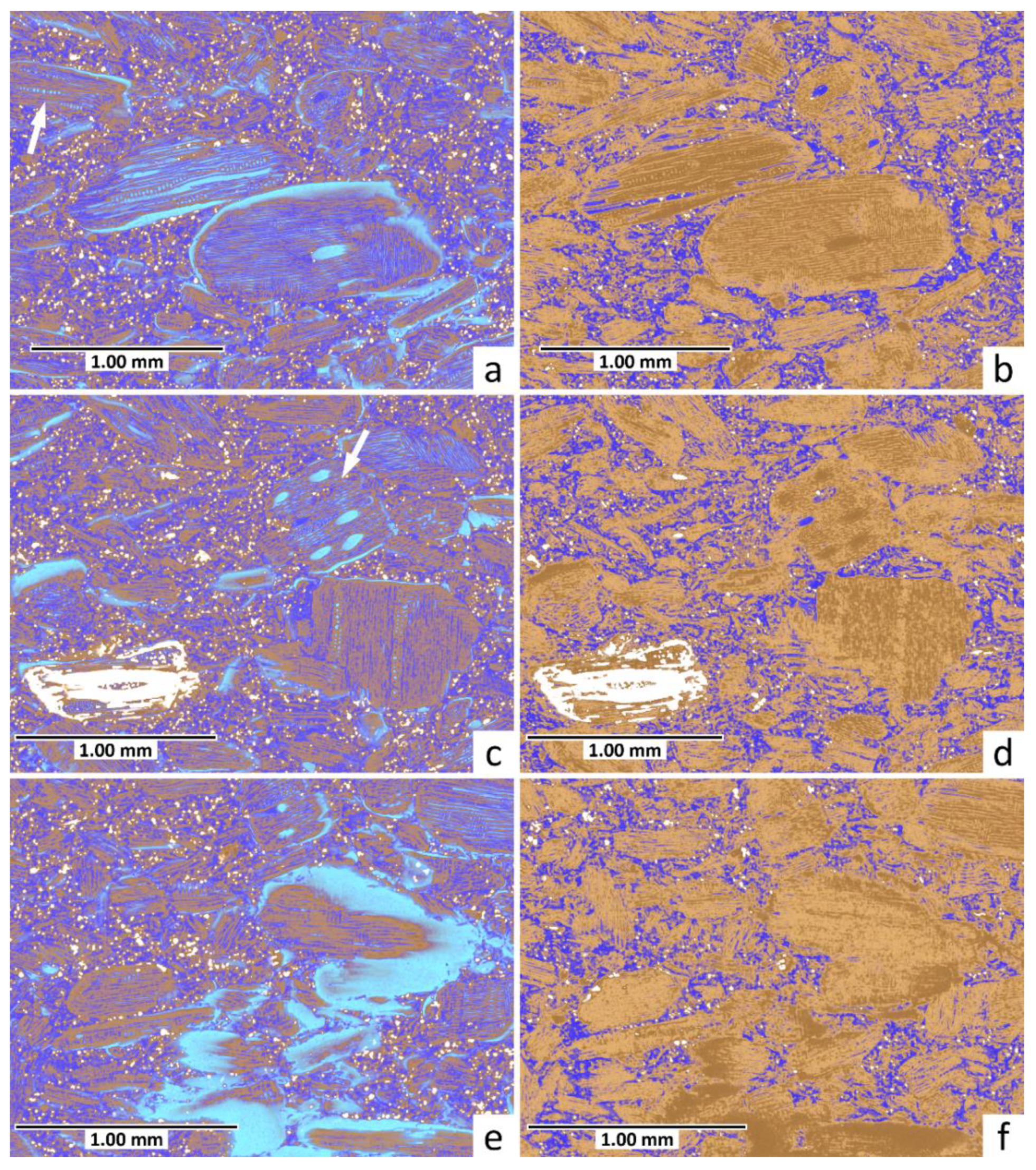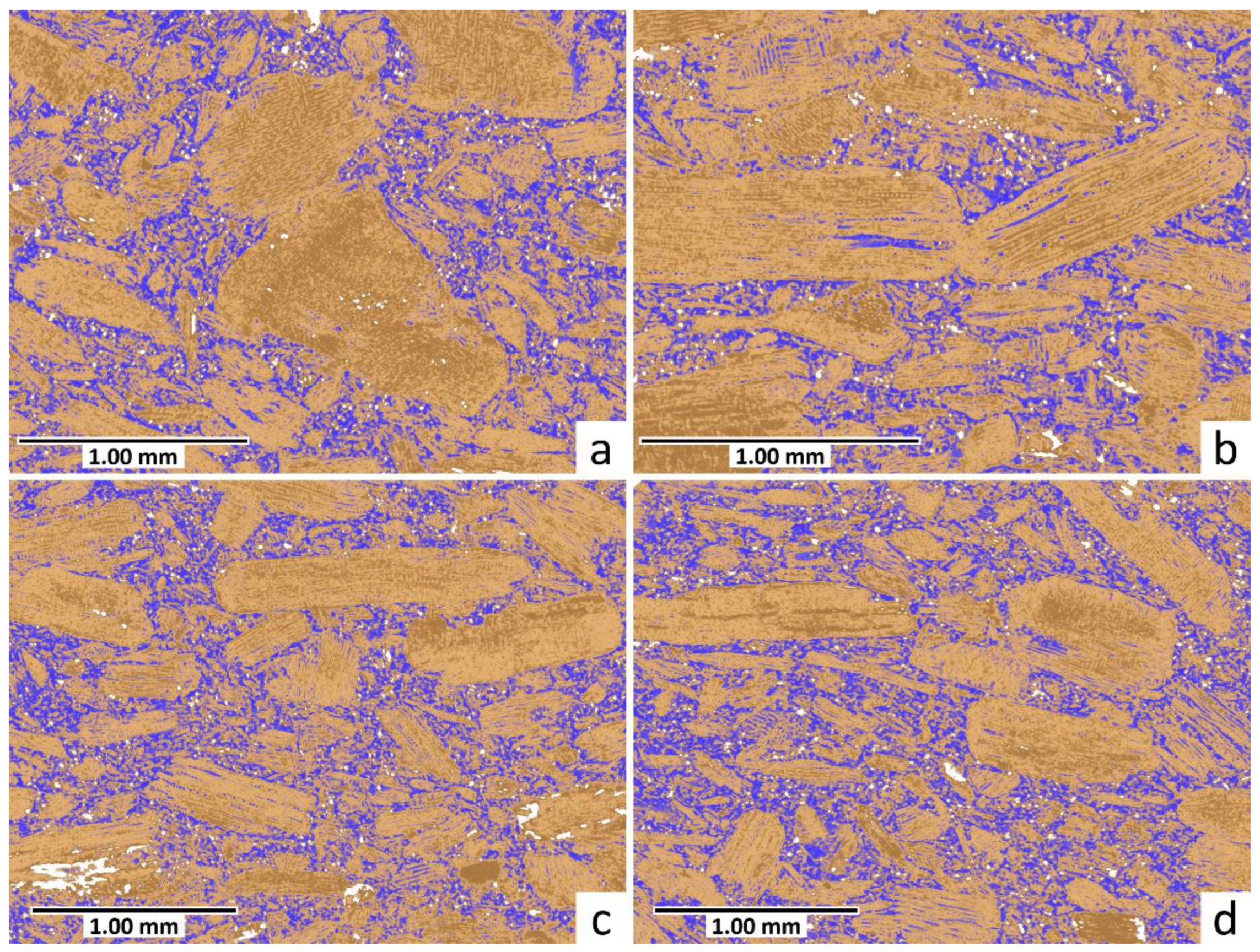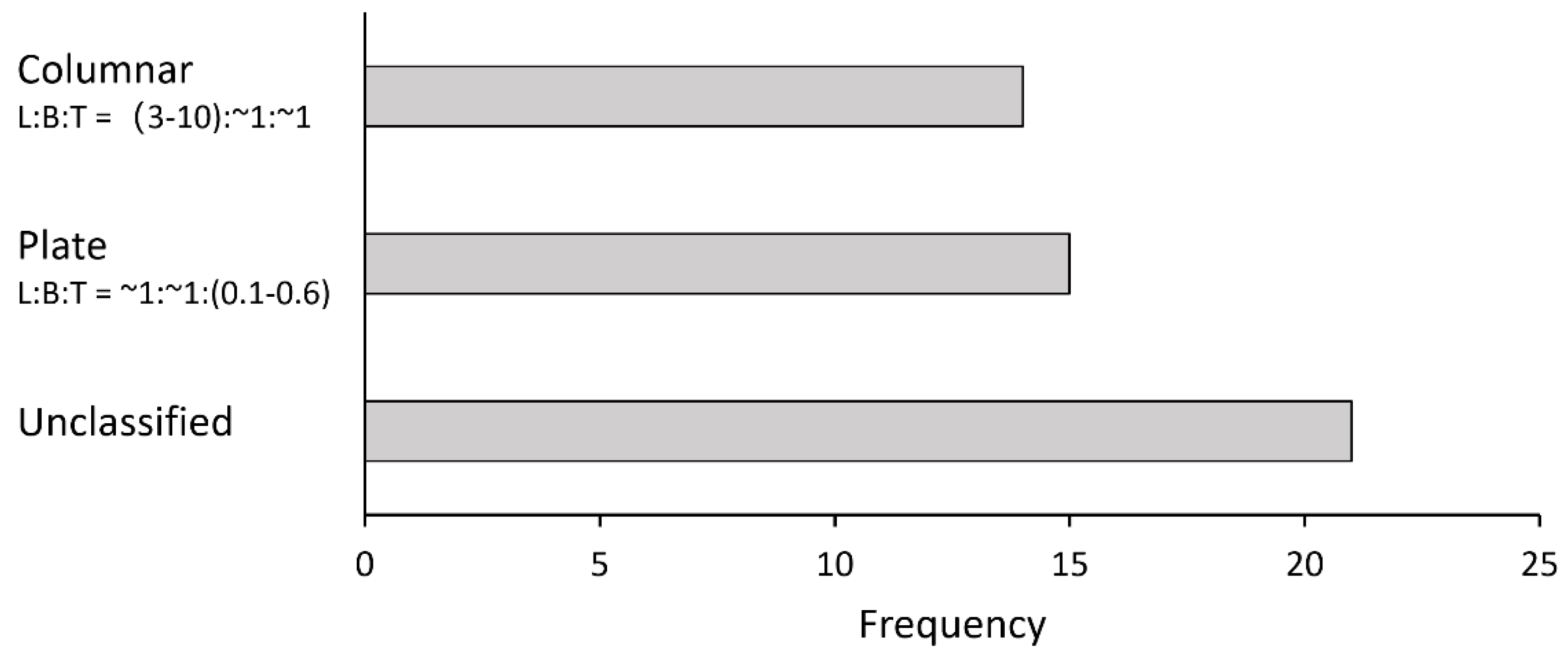Sodium Iodide as a Contrast Agent for X-ray Micro-CT of a Wood Plastic Composite
Abstract
1. Introduction
2. Materials and Methods
2.1. Wood Plastic Composite Sample and Initial X-ray Micro-CT
2.2. Impregnation of WPC Sample with Sodium Iodide and X-ray Micro-CT
2.3. Visualization and Numerical Analysis of Different Phases in WPC Sample
2.4. Numerical Analysis of Geometry of Wood Particles in WPC Sample
3. Results
3.1. Visualization of Phases in WPC before and after Impregnation with NaI
3.2. Quantification of Different Phases in WPC following Labeling with NaI
3.3. Quantification of Wood Particle Sizes and Geometry
4. Discussion
5. Conclusions
Author Contributions
Funding
Institutional Review Board Statement
Informed Consent Statement
Data Availability Statement
Acknowledgments
Conflicts of Interest
References
- Popescu, C.M. Wood as bio-based building material. In Performance of Bio-Based Building Materials; Brischke, C., Jones, D., Eds.; Woodhead Publishing: Cambridge, UK, 2017; pp. 21–96. [Google Scholar] [CrossRef]
- Clemons, C.M.; Rowell, R.M.; Plackett, D.; Segerholm, B.K. Wood/nonwood thermoplastic composites. In Handbook of Wood Chemistry and Wood Composites, 2nd ed.; Rowell, R.M., Ed.; CRC Books: Boca Raton, FL, USA, 2013; pp. 473–508. [Google Scholar]
- Wang, Y. Morphological Characterization of Wood Plastic Composite (WPC) with Advanced Imaging Tools: Developing Methodologies for Reliable Phase and Internal Damage Characterization. Master’s Thesis, Oregon State University, Corvallis, OR, USA, July 2007. [Google Scholar]
- Verhey, S.A.; Laks, P.E. Wood particle size affects the decay resistance of woodfiber/thermoplastic composites. For. Prod. J. 2002, 52, 78–81. [Google Scholar]
- Stark, N.M.; Rowlands, R.E. Effects of wood fiber characteristics on mechanical properties of wood/polypropylene composites. Wood Fiber Sci. 2003, 35, 167–174. [Google Scholar]
- Chaudemanche, S.; Perrot, A.; Pimbert, S.; Lecompte, T.; Faure, F. Properties of an industrial extruded HDPE-WPC: The effect of the size distribution of wood flour particles. Constr. Build. Mater. 2018, 162, 543–552. [Google Scholar] [CrossRef]
- Schwarzkopf, M.J.; Burnard, M.D. Wood-plastic composites—Performance and environmental impacts. In Environmental Impacts of Traditional and Innovative Forest-based Bioproducts; Kutnar, A., Muthu, S., Eds.; Springer: Singapore, 2016; pp. 19–43. [Google Scholar] [CrossRef]
- Krause, K.C.; Sauerbier, P.; Koddenberg, T.; Krause, A. Utilization of recycled material sources for wood-polypropylene composites: Effect on internal composite structure, particle characteristics and physico-mechanical properties. Fibers 2018, 6, 86. [Google Scholar] [CrossRef]
- Hanhan, I.; Agyei, R.; Xiao, X.; Sangid, M.D. Comparing non-destructive 3D X-ray computed tomography with destructive optical microscopy for microstructural characterization of fiber reinforced composites. Compos. Sci. Technol. 2019, 184, 107843. [Google Scholar] [CrossRef]
- Jezzard, P.; Wiggins, C.J.; Carpnter, T.A.; Hall, L.D.; Jackson, P.; Clayden, N.J.; Walton, N.J. Nuclear magnetic resonance imaging of polymers and polymer composites. Adv. Mater. 1992, 4, 82–90. [Google Scholar] [CrossRef]
- Guild, F.J.; Summerscales, J. Microstructural image analysis applied to fibre composite materials: A review. Composites 1993, 24, 383–393. [Google Scholar] [CrossRef]
- Young, R.J. Analysis of composites using Raman and fluorescence microscopy—A review. J. Microsc. 1997, 185, 199–205. [Google Scholar] [CrossRef]
- Garcea, S.C.; Wang, Y.; Withers, P.J. X-ray computed tomography of polymer composites. Compos. Sci. Technol. 2018, 156, 305–319. [Google Scholar] [CrossRef]
- Naresh, K.; Khan, K.A.; Umer, R.; Cantwell, W.J. The use of X-ray computed tomography for design and process modeling of aerospace composites: A review. Mater. Des. 2020, 190, 108553. [Google Scholar] [CrossRef]
- Muszynski, L. Imaging wood plastic composites (WPCs): X-ray computed tomography, a few other promising techniques, and why we should pay attention. BioResources 2009, 4, 1210–1221. [Google Scholar]
- Evans, P.D.; Morrison, O.; Senden, T.J.; Vollmer, S.; Roberts, R.J.; Limaye, A.; Arns, C.H.; Averdunk, H.; Lowe, A.; Knackstedt, M.A. Visualization and numerical analysis of adhesive distribution in particleboard using X-ray micro-computed tomography. Int. J. Adhes. Adhes. 2010, 30, 754–762. [Google Scholar] [CrossRef]
- Evans, P.D.; Lube, V.; Averdunk, H.; Limaye, A.; Turner, M.; Kingston, A.; Senden, T.J. Visualizing the microdistribution of zinc borate in oriented strand board using X-ray microcomputed tomography and SEM-EDX. J. Compos. 2015, 630905. [Google Scholar] [CrossRef][Green Version]
- Paris, J.L.; Kamke, F.A.; Mbachu, R.; Gibson, S.K. Phenol formaldehyde adhesives formulated for advanced X-ray imaging in wood-composite bondlines. J. Mater. Sci. 2014, 49, 580–591. [Google Scholar] [CrossRef]
- Kamke, F.A.; McKinley, P.E.; Ching, D.J.; Zauner, M.; Xiao, X. Micro X-ray computed tomography of adhesive bonds in wood. Wood Fiber Sci. 2016, 48, 2–16. [Google Scholar]
- Bacaicoa, I.; Lütje, M.; Sälzer, P.; Umbach, C.; Brückner-Foit, A.; Heim, H.P.; Middendorf, B. Comparative investigation of two-dimensional imaging methods and X-ray tomography in the characterization of microstructure. Mater. Test. 2017, 59, 829–836. [Google Scholar] [CrossRef]
- Wang, Y.; Muszynski, L.; Simonsen, J. Gold as an X-ray CT scanning contrast agent: Effect on the mechanical properties of wood plastic composites. Holzforschung 2007, 61, 723–730. [Google Scholar] [CrossRef]
- Walther, T.; Thoemen, H. Synchrotron X-ray microtomography and 3D image analysis of medium density fiberboard (MDF). Holzforschung 2009, 63, 581–587. [Google Scholar] [CrossRef]
- Morrison, O. Resin Distribution in Particleboard. Bachelor’s Thesis, The Australian National University, Canberra, Australia, November 2004. [Google Scholar]
- Sheppard, A.; Latham, S.; Middleton, J.; Kingston, A.; Myers, G.; Varslot, T.; Fogden, A.; Sawkins, T.; Cruikshank, R.; Saadatfar, M.; et al. Techniques in helical scanning, dynamic imaging and image segmentation for improved quantitative analysis with X-ray micro-CT. Nucl. Instrum. Methods Phys. Res. B 2014, 324, 49–56. [Google Scholar] [CrossRef]
- Limaye, A. Drishti: A volume exploration and presentation tool. In Developments in X-ray Tomography VIII; International Society for Optics and Photonics: Bellingham, WA, USA, 2012; Volume 8506, p. 85060X. [Google Scholar]
- Siau, J.F. Wood: Influence of Moisture on Physical Properties; Virginia Polytechnic Institute and State University: Blacksburg, VA, USA, 1995. [Google Scholar]
- Adebayo, A.B.; Dawson-Andoh, B.; Georg, B.P.; Nkansah, K.; Medley, C. Adsorption and desorption performance of two commercial wood plastic composites. For. Prod. J. 2008, 58, 32–36. [Google Scholar]
- Youssef, S.; Rosenberg, E.; Gland, N.F.; Kenter, J.A.; Skalinski, M.; Vizika, O. High resolution CT and pore-network models to assess petrophysical properties of homogeneous and heterogeneous carbonates. In Proceedings of the 2007 SPE/EAGE Reservoir Characterization and Simulation Conference, Abu Dhabi, United Arab Emirates, 28 October 2007; p. 111427. [Google Scholar]
- Wadell, H. Volume, shape, and roundness of quartz particles. J. Geol. 1935, 43, 250–280. [Google Scholar] [CrossRef]
- Merkus, H.G. Particle Size Measurements: Fundamentals, Practice, Quality; Springer: Pijnacker, The Netherlands, 2009. [Google Scholar]
- Mankowski, M.E.; Manning, M.J.; Slowik, D.P. Durability of capped wood plastic composites. In Proceedings of the 111th Annual Meeting of the American Wood Protection Association, Asheville, NC, USA, 12–14 April 2015; pp. 124–132. [Google Scholar]
- Lötter, B.T.; Evans, P.D. Sprayable hot melt waxes as water repellents for oriented strand board. Int. Wood Prod. J. 2019, 10, 102–110. [Google Scholar] [CrossRef]
- Gardner, D.J.; Han, Y.; Wang, L. Wood–plastic composite technology. Curr. For. Rep. 2015, 1, 139–150. [Google Scholar] [CrossRef]
- Steckel, V.; Clemons, C.M.; Thoemen, H. Effects of material parameters on the diffusion and sorption properties of wood-flour/polypropylene composites. J. Appl. Polym. Sci. 2007, 103, 752–763. [Google Scholar] [CrossRef]
- Sun, G.; Ibach, R.E.; Faillace, M.; Gnatowski, M.; Glaeser, J.A.; Haight, J. Laboratory and exterior decay of wood–plastic composite boards: Voids analysis and computed tomography. Wood Mater. Sci. Eng. 2016, 12, 263–278. [Google Scholar] [CrossRef]
- Morrell, J.J.; Stark, N.M. Durability of wood-plastic composites. Wood Des. Focus 2006, 16, 7–10. [Google Scholar]
- Gnatowski, M.; Ibach, R.; Leung, M.; Sun, G. Magnetic resonance imaging used for the evaluation of water presence in wood plastic composite boards exposed to exterior conditions. Wood Mater. Sci. Eng. 2015, 10, 94–111. [Google Scholar] [CrossRef]
- Chen, H.C.; Chen, T.Y.; Hsu, C.H. Effects of wood particle size and mixing ratios of HDPE on the properties of the composites. Holz Als Roh Werkst. 2006, 64, 172–177. [Google Scholar] [CrossRef]
- Takatani, M.; Ikeda, K.; Sakamoto, K.; Okamoto, T. Cellulose esters as compatibilizers in wood/poly(lactic acid) composite. J. Wood Sci. 2008, 54, 54–61. [Google Scholar] [CrossRef]
- Lin, H.; Li, R.; Li, D.; Huang, Z.; Pang, J.; Zhang, X.; Liu, W.; Yang, W. Hydrophobic wood flour derived from a novel p-TsOH treatment for improving interfacial compatibility of wood/HDPE composites. Cellulose 2020, 27, 4053–4065. [Google Scholar] [CrossRef]
- Madyan, O.A.; Wang, Y.; Corker, J.; Zhou, Y.; Du, G.; Fan, M. Classification of wood fibre geometry and its behaviour in wood poly(lactic acid) composites. Composite A 2020, 133, 105871. [Google Scholar] [CrossRef]
- Strohmann, T.; Bugelnig, K.; Breitbarth, E.; Wilde, F.; Steffens, T.; Germann, H.; Requena, G. Semantic segmentation of synchrotron tomography of multiphase Al-Si alloys using a convolutional neural network with a pixel-wise weighted loss function. Sci. Rep. 2019, 9, 19611. [Google Scholar] [CrossRef] [PubMed]
- Furat, O.; Wang, M.; Neumann, M.; Petrich, L.; Weber, M.; Krill, C.E.; Schmidt, V. Machine learning techniques for the segmentation of tomographic image data of functional materials. Front. Mater. 2019, 6, 145. [Google Scholar] [CrossRef]






| Composition/Phases | Before Labeling | After Labeling | Adjusted * |
|---|---|---|---|
| Voids within WPC | 5.1 (8.5%) | - | 5.1 (8.5%) |
| Wood particles | - | 46.2 (65.6%) | 32.2 (54.1%) |
| Plastic matrix | - | - | 20.9 (35.1%) |
| Zinc borate biocide/fire retardant | 1.4 (2.29%) | 0.39 (0.56%) | 1.4 (2.3%) |
Publisher’s Note: MDPI stays neutral with regard to jurisdictional claims in published maps and institutional affiliations. |
© 2021 by the authors. Licensee MDPI, Basel, Switzerland. This article is an open access article distributed under the terms and conditions of the Creative Commons Attribution (CC BY) license (https://creativecommons.org/licenses/by/4.0/).
Share and Cite
Feng, D.; Turner, M.; Evans, P.D. Sodium Iodide as a Contrast Agent for X-ray Micro-CT of a Wood Plastic Composite. Appl. Sci. 2022, 12, 208. https://doi.org/10.3390/app12010208
Feng D, Turner M, Evans PD. Sodium Iodide as a Contrast Agent for X-ray Micro-CT of a Wood Plastic Composite. Applied Sciences. 2022; 12(1):208. https://doi.org/10.3390/app12010208
Chicago/Turabian StyleFeng, Dengcheng, Michael Turner, and Philip D. Evans. 2022. "Sodium Iodide as a Contrast Agent for X-ray Micro-CT of a Wood Plastic Composite" Applied Sciences 12, no. 1: 208. https://doi.org/10.3390/app12010208
APA StyleFeng, D., Turner, M., & Evans, P. D. (2022). Sodium Iodide as a Contrast Agent for X-ray Micro-CT of a Wood Plastic Composite. Applied Sciences, 12(1), 208. https://doi.org/10.3390/app12010208






